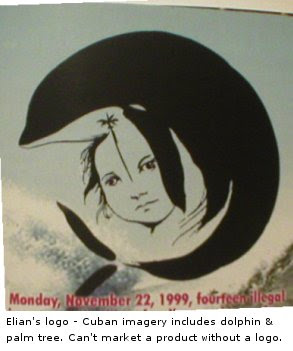
So what was I saying about Cuba? Oh, yeah - expect the unexpected. One morning we had been lying on the beach for about an hour when a black dot appeared offshore. As it got closer and closer, it began to look less like a black dot and more like a spear fisherman in a black wetsuit with a
facemask wading ashore from... somewhere. In a net bag he had a large octopus and a fat grouper - both of which turned up in the buffet that night. Now that's fresh seafood. We didn't get a picture of him, but we did get a picture of another fisherman bringing in what would be that day's lunch (grilled to a golden brown) and dinner (poached) options.
Husband made an interesting observation; not one single time did anyone ever ask us, or did we ever hear anyone ask, the most prevalent conversation-starter back in North America: "What do you do?" Instead people ask "Where are you from? How did you find out about this resort? Have you been to Cuba often?" The result, he noted, is an erasure of a lot of class distinctions that exist back in Canada based on occupation and social status.
There are, however, no matter how friendly and respectful we may try to be, significant distinctions, if not of class then of material wealth, between the
turist(o)(a)s and the resort workers. As a result, an informal but now traditional custom of tipping staff, either with convertible pesos ("tourist money" which is worth much more than the Cuban peso) or with gifts, has become common. We were made aware of this before we went by friends who'd been there, and from there did a lot of research on what to take to "gift" friends and workers. Simple toiletries like
deodorant, toothpaste and moisturizing cream are available in Cuba but priced beyond most ordinary peoples' means. Ditto pantyhose, which some women are required to wear to work but which are incredibly expensive. School supplies (pencils, notebooks, crayons) are prized. Children's clothing and toys are very hard to find and when you can find them, again, they're expensive. (I read in an article that a pair of adult blue jeans costs approximately one months' salary for a Cuban accountant.) Little "extra treats" for these hardworking women (we took nail polish and pretty hair clips, for example) are also much appreciated. Anything is helpful - that which isn't wanted or used by the recipient becomes barter, just as good.
These gifts are left for housekeepers each morning on the pillow of the bed; they would
never assume anything else in the room was a gift for them, but it is understood that anything left on the pillow was for them.
Liannes, the housekeeper taking care of us, was so earnestly grateful for our small gifts that I was quite embarrassed.
I got a great tip when I read on
Tripadvisor.com that taking a good-quality baseball for a special friend is a great gesture in this
beisbol-mad country. I picked up a couple of authentic
MLB balls at the local
Wal-mart for under $2 apiece.
Isela, the woman who is taking care of Lucky the cat, has a young son; and before she left for her own vacation a few days before we left, I took her one of the baseballs. What a commotion! The two male resort workers who were visiting with her grabbed the ball, speaking Spanish enthusiastically and inspecting it - carefully. "Is
real!" declared one approvingly, after carefully scrutinizing the Authentic Major League Baseball logo.
Isela was very pleased with it, and I hope her little guy plays with it happily for a long time. The second ball I left for Liannes on our last morning there.
As you can imagine, this whole system feels a little bit weird; there is, I suppose, a danger of beginning to get some kind of Lady Bountiful complex if you are that sort of person. As for me, I was torn between feeling weird about it and genuinely wanting to share things with these good, friendly, kind people, and that, along with the understanding that there was no "me" to it, this was the system that evolved and it didn't make
me anything special, balanced out to a general nice feeling of sharing with people I'd come to like. Finally, I was relieved to not see a single incident of people being rude, disrespectful or condescending to staff. I was afraid these inexpensive vacations might encourage some reg'lar folks back home to start thinking of themselves as landed gentry in Cuba with the serving class there to wait upon them. Instead, it seems everyone saw the staff for exactly what they were - people at work, doing a job and earning a living, just like we are when we're back at home.
Regarding the Cubans' homes and home lives, Sherwood noted while looking at the photos that there are overhead electrical wires. Private homes are wired, however, brownouts and blackouts are extremely common (and I understand there is some eyebrow-raising at the fact that the resorts miraculously seem to shine brightly while lights dim all around). You are not allowed to bring any heavy power-drawing appliances into the country - no irons, hair dryers or curling irons - and must use the
resort's low-draw ones. (I called our room's hair dryer "The Bart Simpson Hair Dryer" because, to paraphrase him, "I didn't believe it was possible, but this thing blows and sucks at the same time.") I wasn't inside any private homes so can't speak to water and sewage, but most public places have modern bathrooms (the resort had surprisingly modern European fixtures). Toilet paper, however, is a very scarce commodity, on-resort and off; and the smart traveler is not caught without her purse pack of Kleenex [
tm]! Some public washrooms have washroom attendants who hand you a few squares of paper before you go into a stall. Usually female attendants - even in the men's rooms. ("Did that freak you out a little bit?" I asked. "Yep," Husband replied without hesitation.)
In fact the whole trip, like many peoples' first forays into the developing world, made us extremely conscious all of a sudden about our consumption; how much paper (even toilet paper) we were using, how much water (only bottled is safe to drink for tourists) we were drinking, how much we were running the air conditioning, how much food we were taking from the buffet. Leftovers are recycled into new dishes or put out for a second meal, something which some other visitors to this resort complained bitterly about in online reviews; in a country where even the resorts are on rations and shortages are everywhere, it seemed the height of reason to us.

A final observation about Cuba is the place of Ché Guevara in Cuban life, culture, and tourism. Fidel is quoted here and there, cited now and then, but Ché - Ché is
idolized in Cuba. It is his image that people have painted on their front porches or stone gates; his picture that hangs on office walls; and his quotations and image that grace everything from t-shirts to tote bags to an entire series of "images from the life of Ché" postcards in the gift shop.
His prevalence in the souvenir stores is understandable - he is embraced and adored by middle-class European and North American leftists with a greater or (much) lesser understanding of the story behind the iconography they're sporting. But it is his presence in the homes and offices of ordinary Cubans that impressed me - he is someone they look to, here, even those too young to remember him personally. (An American newspaper article I read before leaving echoed in my mind while I was there. When someone complains about conditions in Cuba, it said, the most common response is, "We need another Ché.")

Even in the tourist shops, the nature of the Ché sentimentalia is telling; a book available in French, English, Spanish and German is entitled Fidel and Ché; a Great Friendship and feels distinctly like there might be some... coattail-riding going on there.
(Speaking of books, remind me to tell you about my last-minute souvenir purchase - a remarkable propaganda piece which goes oh, so far in explaining why the Cubans' stubborn fidelity to Fidel and the current regime is so deeply entrenched in spite of great deprivation.)
I mentioned the overwhelming public face of Ché as compared to Fidel to Husband. "Fidel got to survive," he said wryly. "Ché is John Lennon. He didn't live long enough to become Ringo."
Those of you who have traveled much more extensively that we have know that this kind of "first" trip is a life-changing experience. You come back a slightly different person - nobody else can see it, but you can feel it inside. It's a good feeling, like you grew a little bit as a person. It also makes you hungry for more, you bet. So the only questions for us now are: Where next? Cuba again? (Probably - as a co-worker warned me, "Be careful. You'll love the Caribbean, but you'll fall in love with Cuba.") This resort, or someplace else? And one week again, or two? (We've already answered that: two. For starters.)
We've already started re-filling the ol' vacation account.
Now, if I could only figure out why there is half-a-bag of Tostitos in the living room. I don't remember buying Tostitos - ever.
ronnie
Labels: vacation

























